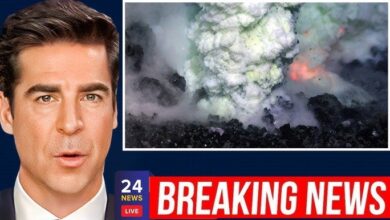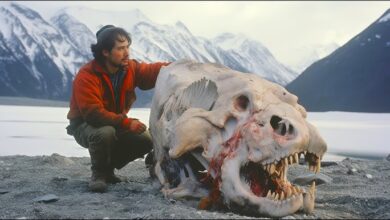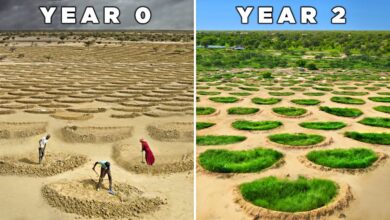100ft Wide Crack Opens in Yellowstone National Park – Scientists Race to Find Answers

The narrative describes a series of events around the eruption of Mount Vesuvius in Italy, starting with minor tremors and escalating into a catastrophic eruption. Here is a breakdown:
- Day 1-3: Tremors begin in Naples, Italy, signaling activity at Mount Vesuvius, a stratovolcano famous for its eruption in AD 79 that destroyed Pompeii. Experts monitor the volcano closely, using seismic stations and GPS arrays to track ground movement and gas emissions. Though the volcano is long overdue for an eruption, it seems calm initially.
- Day 4-6: The tremors intensify, cracks form in the ground, and dangerous gases like carbon dioxide and hydrogen sulfide are released. Local animals are affected, and the area becomes hazardous. Seismic activity suggests the eruption could be imminent.
- Day 7-16: Local authorities issue evacuation orders, and the process of moving 600,000 people from the danger zone begins. The evacuation continues despite chaos, with some people refusing to leave. By day 16, the evacuation is complete.
- Day 16-20: The eruption begins with loud explosions, volcanic rock and lava are thrown into the air, and a massive landslide occurs. Ash and rocks spread across the landscape, covering towns and destroying buildings. Nearby towns are engulfed in molten lava, and the sky becomes dark with ash. The eruption is one of the most violent in history, with severe regional impacts, including the contamination of water supplies and the cessation of air travel.
- Post-Eruption: The area remains off-limits, and the region is covered in lava and ash. It will take years to fully understand the eruption’s global and local impacts. Similar volcanic eruptions have occurred throughout history, with one of the most notable being the eruption of Mount Tambora in 1815, which caused the “Year Without a Summer.”
- Final Thoughts: The aftermath of volcanic eruptions can drastically alter the climate and environment. The 2021 eruption of Hunga Tonga is an example of how such eruptions can influence global weather patterns. Historical eruptions like Mount Tambora have caused widespread devastation, and scientists continue to study volcanic activity to predict future events and their consequences.

Iceland’s geological features are shaped by its young lava fields, with many dating back less than 1,000 years. The island is highly active in terms of volcanic eruptions, with scientists predicting more frequent eruptions in the future. Iceland was first settled by Norse Vikings in the 10th century, who were shocked by a major volcanic eruption shortly after their arrival. Despite this, Icelanders are now accustomed to volcanic events, which are likely to continue.
Volcanic eruptions in the past have been linked to Earth’s ice ages, with glaciers affecting the flow of magma underground. When glaciers retreated, the pressure was lifted, allowing magma to erupt more easily. A catastrophic type of eruption, called a flood basalt eruption, occurred around 252 million years ago, causing mass extinctions and a long recovery period for the planet.
Scientists warn that a similar event could occur again in the future, though not for hundreds of millions of years. In the short term, volcanic activity is primarily underwater, with volcanoes on the ocean floor forming new islands over time. A mass eruption of all volcanoes on Earth could result in devastating consequences, including ash clouds, acid rain, and massive disruptions to life on the planet. However, the chances of all volcanoes erupting simultaneously are very slim due to the separate magma sources.
There are concerns about supervolcanoes like Yellowstone, which could have catastrophic global effects, though current monitoring indicates no imminent threat. Iceland’s recent eruption was not catastrophic but highlights the unpredictable nature of volcanoes, which can be dangerous due to lava flows and toxic gases.
Volcanoes are some of the most terrifying natural phenomena, with the potential to cause major disasters for both humans and the environment. Some volcanoes can appear suddenly and grow rapidly, such as the Parícutin volcano in Mexico, where an eruption began in an open field in 1943 and grew to over 1,500 feet in just one year. However, some large volcanoes, such as Fuji in Japan, have a long history of eruptions and are capable of erupting again at any time, as happened in 1707, when hot rock fragments from the volcano fell as far as 60 miles away.

The danger of volcanoes lies not only in their eruptions, but also in rare phenomena such as “dirty thunderstorms” – when volcanic ash clouds produce lightning – and “volcanic tsunamis” caused by tectonic plate movements. The Taal Volcano in the Philippines, which erupted in January 2020, is a prime example, as it not only produced ash but also threatened surrounding areas with volcanic tsunamis.
Volcanoes around the world can pose a variety of hazards, from hot lava flows and toxic gases to “lahars” – volcanic mudflows that can occur when melting snow or a lake in the crater overflows. Anak Krakatau in Indonesia is a prime example, which has been at risk of frequent eruptions since the great flood of 1883. Campi Flegrei in Italy, while not as tall as Vesuvius, is potentially dangerous, with signs of increased activity in recent years.
Meanwhile, supervolcanoes like Yellowstone in the US, although they may not erupt for a long time, when they do erupt, the power of the explosion can be equivalent to 10 nuclear power plants. These supervolcanoes have the potential to change the entire climate of the planet, like the eruption of Mount Toba about 74,000 years ago, causing the Earth’s temperature to drop significantly and causing a volcanic winter that lasted for years.
Although supervolcanic eruptions are very rare, the odds of one occurring in a human lifetime are about 1 in 1,400. However, the rapid change of geological plates and the unpredictable changes in volcanic regions keep scientists on guard for the possibility of a sudden eruption in the near future.
Imagine being caught in a volcanic eruption where lava flows at incredible speeds, faster than any human could run. The initial danger is the lava itself, which moves unpredictably depending on the terrain, but more perilous are the toxic gases that could make breathing difficult or even cause unconsciousness. Fortunately, everyone in your group has gas masks, but the path ahead is treacherous, with slippery mud and vines obstructing progress.
As you venture deeper into the jungle to escape the eruption, wild animals like bears and rhinos rush past you in panic. Lava strikes the jungle, igniting fires, and the ground shakes violently. Eventually, you reach a river but must navigate over slippery rocks, only to face the terrifying sight of lava flowing into the river, raising the temperature of the water to dangerous levels. A person gets trapped between rocks, but with quick thinking, you manage to free them just in time.
The journey continues as you approach a road that leads to a broken bridge. Other survivors are already fleeing, and though the volcano’s eruption is still ongoing, you’ve reached a relatively safer area. However, you’re still at risk of earthquakes caused by the supervolcano, which is powerful enough to cause massive destruction. Scientists are studying these supervolcanoes, like Italy’s Campi Flegrei, where recent earthquakes have raised concerns. Local authorities are preparing evacuation plans, and while the eruption of a supervolcano is extremely rare, it’s a constant threat.
The passage then shifts to a historical account of Pompeii’s destruction by Mount Vesuvius in 79 CE, describing the catastrophic eruption that buried the city. The segment explains the nature of supervolcanoes, their potential for catastrophic eruptions, and the consequences of such events, including the eruption at Lake Tapo in New Zealand. Though such eruptions are rare, they can change the climate and affect the entire planet.
Lastly, the passage touches on ongoing scientific projects aimed at studying magma chambers, such as the Iceland deep drilling project, which could potentially turn magma into a renewable energy source. It highlights humanity’s ongoing efforts to understand and harness the power of volcanoes for future energy needs.
Some facts and research related to volcanoes and the technology of extracting geothermal energy from magma, along with discoveries in deciphering ancient texts.
1. **Icelandic magma mining project**: This project was originally planned to drill 13,000 ft underground but after drilling to a depth of 6,900 ft, they encountered magma. Although their equipment was not capable of dealing with this, the discovery opened up new opportunities for the extraction of geothermal energy from magma. Scientists are now working to develop safe technology to drill into magma chambers and study the possibility of clean energy production.
2. **Cwla magma test project**: The goal of the project is to create a magma research center where scientists can study geothermal energy and volcanic hazards. Experiments will be conducted to test the possibility of harnessing energy from magma without causing volcanic disasters.
3. **Supervolcanic eruption research**: Scientists are studying supervolcanoes, which can cause globally devastating events, such as the Toba eruption 70,000 years ago. Magma mining projects could help predict these eruptions earlier and prevent disasters.
4. **Ancient scrolls discovered from Herculaneum**: Archaeologists have discovered more than 1,800 charred ancient scrolls from the city of Herculaneum, which was destroyed by Mount Vesuvius. The scrolls have been scanned and deciphered using AI, allowing scientists to read parts of the ancient works, including writings by a Greek scholar.
5. **The Challenge of Decoding Ancient Texts**: In addition to using AI, the process of decoding ancient texts in the past was a time-consuming and laborious task. Ancient books may contain secrets that have not yet been deciphered, and the use of modern technology has helped speed up this process.
6. **The Danger of Ancient Books Containing Toxins**: Some old books may contain toxins, due to the use of dyes containing arsenic in the production of book covers, which can be harmful to the health of readers.
7. **The Emergence of New Islands Due to Undersea Volcanoes**: Describes a new island that is gradually forming in the Sea of Japan, where an undersea volcano is erupting and gradually rising to the surface. These islands can change the landscape and create new ecosystems.
The topics in this passage combine scientific research on geothermal energy and volcanoes with archaeological discoveries related to ancient cultures.
Sulfur deposits interact with hot air and are activated by lava, creating a magical blue phenomenon that can only be seen at night, but can be smelled during the day. The world’s largest acid lake is also located in this crater. The Dead Sea, although a lake, is much saltier than other seas, making swimming very difficult, but people come here to take advantage of the natural minerals in the water. The lake is also the lowest place on land, at 1,400 feet below sea level.
A crystal cave located 1,000 feet underground in Mexico, containing crystals up to 35 feet long and weighing up to 55 tons, is one of the largest crystals in the world. Linty Beach in Scotland, with its vast white sands, is stunning in May and June, but in December it only gets an average of one hour of sunshine a day, creating a mystical scene.
The Georgia Guidestones, erected in 1980, contain inscriptions in eight different languages, including Hindi, Chinese and Swahili, but their purpose is unclear. Sequoia National Park in California is home to giant sequoias, including the General Sherman Tree, the world’s largest living tree.
The famous stone statues on Easter Island have been there for hundreds of years and may have been built to fertilize the land. The hot springs in Pamukkale, Turkey, are colored by minerals and are said to be relaxing for the body and mind.
In Saudi Arabia, a naturally split rock forms a strange shape, and Blood Falls in Antarctica is a vibrant red thanks to a combination of salt water and iron oxide. In 2018, New England saw the longest tornado in the region’s history.
The Tristan da Cunha archipelago, far from the mainland, is a place where you can live with 280 residents and be completely cut off from the outside world. Additionally, the sea froze in Massachusetts in January 2018, allowing people to walk on the waves, and Tianjin Beach in China is famous for its red grass covering the entire beach.
Witness a giant boulder swaying from side to side on a cliff, but it fell in 1912 and only a plastic replica remains in Tandel. The “dragon” tree on Yemen’s Socotra Island is one of the strangest trees in the world.
Fire Tornadoes are fiery tornadoes that occur during wildfires, carrying flames and burning debris. The House of Mystery in Gold Hill is famous for its reverse gravity phenomena, where objects can move against the direction of gravity.
The Rainbow Eucalyptus tree has bark that changes color over time, creating a beautiful color effect. The ancient city of Shibam in Yemen is known as the “Manhattan of the Desert” for its ancient clay buildings.
The sight of volcanic eruptions and their effects on the atmosphere and life on Earth has created a protective atmosphere and oceans. Without volcanoes, Earth would have no air, water, or life. However, the current cessation of volcanic activity would also have many consequences.
In short, without volcanoes, Earth would lack air, water, and the benefits that volcanoes bring to our lives and environment.








